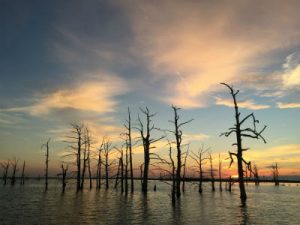Louisiana’s Roseau Cane: Why It’s Important and What’s Eating It Away
I was kicking up mud as we skimmed over a newly created mudflat just downstream from the West Bay Diversion. New land with vibrant flora and fauna spread in every direction, a product of diverting sediment-laden river water and strategically depositing dredged material from navigation channels of the Mississippi River. My two passengers with the Plaquemines Association of Business and Industry (PABI), Bobby Thomas and Mike Van Haverbeke, were pleasantly surprised at industrial development and coastal stewardship colliding to create new wetlands.
Passing an area of increased wetland growth, we headed into the Birdsfoot Delta to inspect an alarming new development—damage to the delta’s most hardy and widespread wetland plant species, roseau cane.
The Mississippi River Delta is home to the world’s largest contiguous stand of roseau cane, commonly known as giant reed. These hardy plants can tolerate high levels of salt and grow out of three feet of water. Despite subsidence rates approaching eight feet per century, this member of the grass family has been able to keep wetlands on the map by trapping sediment in the dense stands of canes that line the passes of the river.
Unfortunately, large swaths of this land-sustaining cane are dying. The canes are being damaged by an infestation of a sap-sucking insect native to China and Japan known as the mealy bug. The insect climbs deep between the stalk and leaf to mine sap from the canes for food, causing the canes to run out of their energy reserves. Damage ranges from discoloration to outright eradication. If this damage continues, the ecological effects will cascade through the food web—affecting red-winged blackbirds and white shrimp.
As we approached an oil and gas facility, the economic consequences of a shrinking delta came into focus. The canes around the facility were in decline. Only 30 percent of the stalks seemed to be alive. The rest were brown. We pooled our three lifetimes of experience in the delta, and none of us were able to think of a time that the canes looked worse. Even the hard freeze of 1989 didn’t cause the same damage. This decline in biomass is going to lead to more exposed critical energy infrastructure. Oil production platforms, while elevated to accommodate the occasional storm surge, just aren’t designed to be in a dynamic offshore environment. Fifteen percent of the nation’s refining capacity is in Louisiana, and 20 percent of the oil and gas used in the country travels through south Louisiana. Protecting this infrastructure is of utmost importance to the national economy. It’s not just oil and gas infrastructure that will be affected by the newest invasive species in the delta. As canes begin to die back and water is able to escape the delta more quickly, a necessary increase in dredging along the lower river will affect navigation interests along the Mississippi River corridor.
Dealing with these invasive pests is proving difficult. Burning the cane is an option but difficult because the canes grow out of water. Oil and gas infrastructure interspersed throughout the delta makes burning a problem too. Insecticide would create problems for aquatic animals like shrimp, crabs and fish in their larval states, and, besides, the bugs are buried deep between the leaves and stalk of the plant. Some individual roseau cane plants show signs of resistance to the pests. Scientists are currently seeking funding to study what makes these individual plants more resistant to the invading bugs and if these plants can be transplanted to other impacted areas. Hopefully, over time, the effects of the infestation will begin to stabilize.
As our trip ended at the Venice Marina, we saw charter captains returning with the day’s catch – including tuna, snapper, speckled trout, redfish and flounder. We reflected on just how important the wetlands are for the economy, ecology and culture of Louisiana.
Defend Louisiana’s Coast Against Devastating Budget Cuts! |
|
 |
The president’s proposed budget would have devastating effects on Louisiana’s coast and the people, wildlife and jobs that depend on it. This is hundreds of millions of dollars in funding that our state desperately needs! Urge your members of congress to protect coastal restoration funding! |


